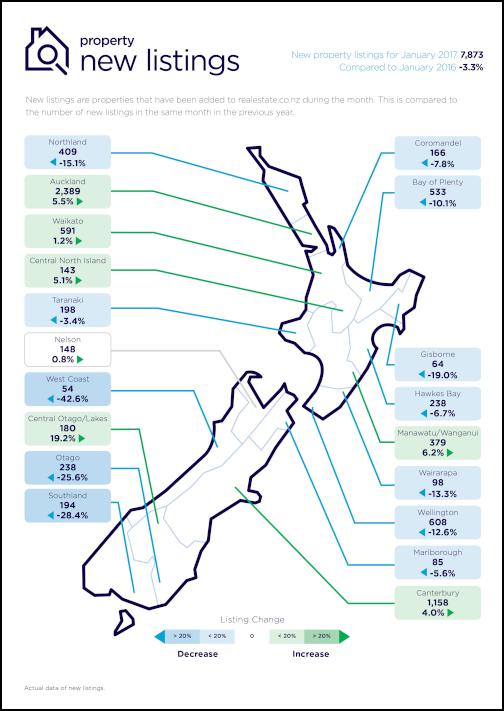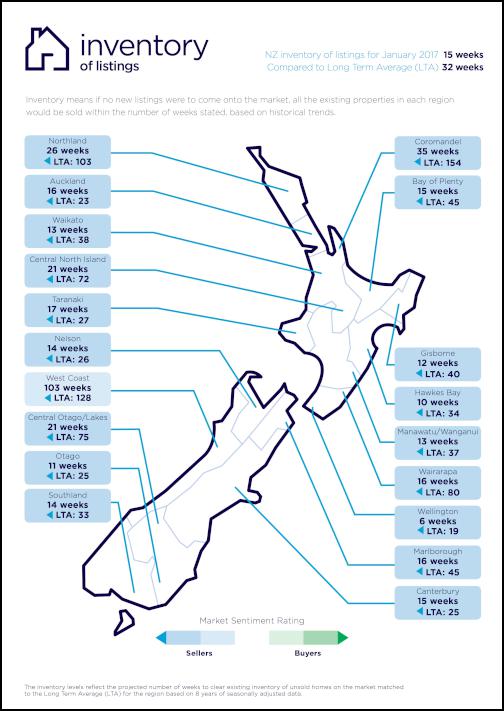Wellington sees 5.6% increase in average asking price
1 FEBRUARY 2017
Property market heats up across the regions - but Auckland isn’t one of them
Nine out of 19 regions in New Zealand recorded an all-time high asking price in January, while prices in Auckland remained static.
“Several regions recorded spikes in the average asking price in January, most notably Central Otago/Lakes, where a 17.6 per cent increase saw the average asking price reach $888,567.
“While the national average asking price climbed just 1.1 per cent last month, this is still an all-time high of $624,709. However, the full set of statistics would suggest that seasonality is still in full swing,” says realestate.co.nz CEO Brendon Skipper.

Real-time market statistics from realestate.co.nz show that Central Otago/Lakes recorded the biggest average asking price increase, followed by Central North Island at 12 per cent ($413,392), Hawkes Bay at 10.8 per cent ($413,405) and Bay of Plenty at 9.8 per cent ($592,479).
“Wellington is always an interesting market to watch and in January was another region showing an all-time high in terms of asking price at 5.6 per cent ($556,807). However, it’s looking light in terms of listings with only six weeks’ worth of inventory, compared to 16 weeks in Auckland,” says Brendon.
Other upward movers included Taranaki at 4.8 per cent ($387,594); Manawatu/Wanganui up 4.7 per cent ($310,437); Otago up 4.6 per cent ($358,897) and Coromandel up 2.3 per cent ($700,352).
“At this point it’s too early to tell if this upward spike will be a trend for 2017,” says Brendon.
The average asking price in Auckland in January was $943,002 compared with the previous month at $949,898.

“In Auckland it’s too early to say whether asking prices have been affected by the traditional seasonality, as the asking price remained quite static in January. However, new listings are up 5.5 per cent compared to January 2016. We have seen another drop in demand in Auckland, down 25.39 per cent, meaning buyers can approach the market with more choice,” says Brendon.
In terms of inventory around New Zealand, Auckland is sitting at 16 weeks; Taranaki is sitting at 17 weeks; Manawatu/Wanganui is sitting at 13 weeks; Otago at 11 weeks and Coromandel at 35 weeks.
Inventory provides a measure of the rate of turnover in the market, by calculating how long it would take for current property stock to sell out if, theoretically, no new properties were to be listed after today.
“Next month should give us a clearer indication of trends across all measures,” says Brendon.
Regions that reached an all-time high in average asking price in January 2017:
Central Otago/Lakes +17.6% ($888,567)
Central North Island +12.0% ($413,392)
Hawkes Bay +10.8% ($413,405)
Bay of Plenty +9.8% ($592,479)
Wellington +5.6% per cent ($556,807)
Taranaki at +4.8% ($387,594)
Manawatu/Wanganui +4.7% ($310,437)
Otago up +4.6% ($358,897)
Coromandel +2.3% ($700,352)

About realestate.co.nz
Dedicated only to property, realestate.co.nz is the official website of the New Zealand real estate industry. As a property listing site, the information it draws on for its property report is in real time. With the country’s most comprehensive selection of real estate listings, realestate.co.nz represents more than 97 per cent of all residential, commercial and rural properties currently marketed by real estate professionals.
Glossary of terms
Being the only provider of real estate data in real time, realestate.co.nz offers valuable property market information not available from other sources.
• Average asking price gives an indication of current market sentiment. Statistically, asking prices tend to correlate closely with the sales prices recorded in future months when those properties are sold. As it looks at different data, average asking prices may differ from recorded sales data released at the same time.
• Inventory is a measure of how long it would take, theoretically, to sell the current stock
at current average rates of sale if no new properties were to be listed for sale. It provides a measure of the rate of turnover in the market.
• New listings are a record of all the new listings on realestate.co.nz for the relevant
calendar month. As realestate.co.nz reflects 97 per cent of all properties listed through registered
estate agents in New Zealand, this gives a representative view of the New Zealand property market.
• Seasonal adjustment is a method realestate.co.nz uses to better represent the core underlying trend of the property market in New Zealand. This is done using methodology from the New Zealand Institute of Economic Research.
• Truncated mean is the method realestate.co.nz uses to provide statistically relevant asking prices.
The top and bottom 10 per cent of listings in each area are removed before the average is
calculated, to prevent exceptional listings
from providing false impressions.
•
Demand: the comparative view per
listing change, by new listing in the previous 3 months
compared to the same time last
year


 John Mazenier: Gaffer Tape And Glue Delivering New Zealand’s Mission Critical Services
John Mazenier: Gaffer Tape And Glue Delivering New Zealand’s Mission Critical Services Earthquake Commission: Ivan Skinner Award Winner Inspired By Real-life Earthquake Experience
Earthquake Commission: Ivan Skinner Award Winner Inspired By Real-life Earthquake Experience Reserve Bank: Consultation Opens On A Digital Currency For New Zealand
Reserve Bank: Consultation Opens On A Digital Currency For New Zealand NIWA: Ship Anchors May Cause Extensive And Long-lasting Damage To The Seafloor, According To New Research
NIWA: Ship Anchors May Cause Extensive And Long-lasting Damage To The Seafloor, According To New Research New Zealand Customs Service: A Step Forward For Simpler Trade Between New Zealand And Singapore
New Zealand Customs Service: A Step Forward For Simpler Trade Between New Zealand And Singapore Horizon Research: 68% Say Make Banks Offer Fraud Protection
Horizon Research: 68% Say Make Banks Offer Fraud Protection



